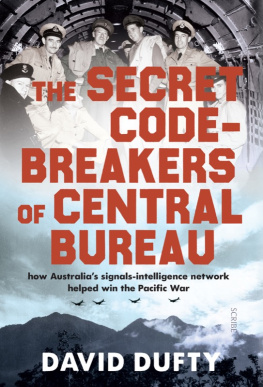Also by Taylor Downing
Night Raid
The World at War
Spies in the Sky
Churchills War Lab
Cold War (with Jeremy Isaacs)
Battle Stations (with Andrew Johnston)
Olympia
Civil War (with Maggie Millman)
The Troubles (as Editor)
SECRET WARRIORS
The Spies, Scientists, and Code Breakers of World War I
Taylor Downing

SECRET WARRIORS
Pegasus Books LLC
80 Broad Street, 5th Floor
New York, NY 10004
Copyright 2014 by Taylor Downing
First hardcover edition April 2015
ISBN: 978-1-60598-694-4
ISBN: 978-1-60598-750-7 (e-book)
All rights reserved. No part of this book may be reproduced in whole or in part without written permission from the publisher, except by reviewers who may quote brief excerpts in connection with a review in a newspaper, magazine, or electronic publication; nor may any part of this book be reproduced, stored in a retrieval system, or transmitted in any form or by any means electronic, mechanical, photocopying, recording, or other, without written permission from the publisher.
Distributed by W. W. Norton & Company, Inc.
For my grandfather
William Forward John Downing
Who operated a Vickers machine gun in the First World War
and survived
Contents
Soon after midnight in the early hours of Tuesday 5 August 1914, the captain of the CS Alert, a cable-laying ship moored at Dover harbour and owned by the General Post Office, received the special coded telegram he had been expecting. He immediately ordered the Alert to slip out of harbour and head north-east. In the early dawn, the captain drew up the Alert in the grey waters of the North Sea a few miles off the German port of Emden, near that countrys border with Holland. It was only about six hours since Britain had formally declared war on Germany at 11 p.m. London time, midnight in Berlin. Having taken up his position, the captain of the Alert ordered the ships grappling equipment to be dropped into the murky waters. The crew of the 1000-ton cable ship were highly skilled in laying and maintaining the undersea cables which, since the mid-nineteenth century, had crossed the bed of the oceans to link continents via telegraphic and, more recently, telephonic communications. They knew exactly how to find the cables to repair them. But this time the vessels mission was destructive. Although the Alert was a civilian ship, the captain was about to engage in an act of war.
After a short period of dredging along the bottom of the sea, the grappling hooks were hauled to the surface bringing with them giant strands of thick, insulated cable that flailed like giant, underwater snakes. Dripping with water and covered in mud and seaweed they were dragged on to the deck of the Alert. The crew sawed and hacked the cables, breaking through them, and then tossed them back overboard into the sea. They then repeated the whole process on four further cables, dragging on board and cutting each one before throwing the ends into the sea. The operation, which took about four hours, was fraught with danger for the unarmed British vessel. The captain and lookouts scanned the horizon for any sign of German ships coming out to see what was going on. As the dawn became brighter the sea grew rougher and a heavy rain squall passed over the ship.
The captain of the Alert was carrying out Britains first offensive act of the First World War. The five German cables that ran across the North Sea and down the English Channel linked Germany with France and Spain and then went out into the Atlantic to Africa and the Americas. They were now severed. Germany could no longer send telegrams or cables to its colonies or to the United States. Cut off from the US and much of the rest of the world, the countrys telegraphic links were now limited to its immediate neighbours across land borders. Berlin had lost its top secret communication link with the new world. From now on, any communication would have to be via radio. And there was one major problem with sending signals by radio. Anyone with a receiver could also tune in and listen to them. This would have significant consequences as the war progressed.
Just over a week later, at dawn on 13 August, another group left Dover. On this day it was the turn of the aviators of the recently formed Royal Flying Corps. For the first time, Britain was sending aircraft to war to accompany its ground troops. It was a chance for the youngest addition to the military to prove itself. Among the small group of fliers gathered was Captain Philip Bennett Joubert de la Fert. Just twenty-seven years of age, he was typical of the first wave of military fliers. He had been in the artillery when he heard about the formation of the Royal Flying Corps and was one of the first officers to join. He had to pay to learn to fly himself (with his fathers support) as the army did not then have funds available to train pilots. Joubert quickly took to flying, although the aircraft were so light and fragile that they needed a lot of care. Most flying took place in the early dawn before the wind had got up and Joubert, like most pilots, had experienced the embarrassment of actually being blown backwards when trying to fly into a strong wind. On one flight he had ended up seven miles behind his point of take-off. When war was declared, Joubert was in command of C Flight in 3 Squadron, flying a French aircraft built by the Blriot company.
For the journey, Joubert, like most of the other pilots, was accompanied by his mechanic. It was the quickest way of transporting to France the men who were essential to keep the aeroplanes flying. Joubert was briefed at about 5.30 a.m. and given maps of France and Belgium and sealed orders. When he opened them, the orders contained details of his destination. Along with the others, Joubert was given a revolver, a set of field glasses and a spare pair of goggles. The mechanics were issued with a tool kit. Emergency rations of biscuits, a bar of chocolate and a pack of soup concentrate were handed out in a haversack. Advance parties at Dover had acquired a large number of cast-off inner tubes. Each man carried one of these, to be inflated if the aircraft came down into the sea and used as a makeshift lifebelt. But the pilots instructions were to ascend to 3000 feet before starting their Channel crossing so if an engine failed they should have enough height to glide across the Channel. There was no planned sea rescue.
The people of Dover cheered as Joubert and his fellow pilots climbed into their aircraft on the hills above the cliffs dominating the town. The contraptions they climbed into consisted of wooden frames held together with wire and covered in linen canvas, powered by large combustion engines that sat imposingly near the centre of the structure. Today they look as ancient as the dinosaurs, but to the crowds gathered on that August morning these craft were the very cutting edge of modernity. Only five years before, Louis Blriot had made the first Channel crossing by air. Now Joubert and the other pilots in their flying machines were planning to carry out a similar journey and to take up their position alongside the British Expeditionary Force.
Soon after 6.25 a.m. on what proved to be a beautiful, clear August day, the first aeroplanes taxied across the grass and soon got up to speed. One after another the pioneers in their Blriots, BE2s, BE8s and Henri Farmans took off and rose high into the sky to reach the planned altitude. Then, in a line, each aircraft, powered by an engine that could only muster a few horsepower, headed off across the Channel at roughly two-minute intervals. Their course was to hit the French coast at Boulogne, fly down the coast to the Somme estuary and then head inland to Amiens. Not everything went to plan. A few aircraft were damaged when they came down in a ploughed field. One pilot got lost and had to land and ask an astonished passer-by where he was. On landing in France, another pilot was arrested by officials who could not understand what language he was speaking and thought he must be a spy. It took three days to get the pilot released from prison. Yet another aircraft was delayed as its pilot flew around the Cap Gris-Nez lighthouse and tried to drop his inner tube, like a quoit, on to the spiky top, as though in a fairground.
Next page











